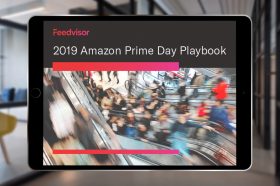Resources - Blog
5 Tips to Optimize Your Inventory Replenishment Process

Stay on top of the latest e-commerce and marketplace trends.
A critical piece of running a large-scale Amazon operation is taking an always-on approach to knowing your business’s inventory position. To avoid being faced with limited storage access or inventory storage overage fees, it is imperative to know what items to restock and the appropriate times to do so.
As a result, you can avoid going out of stock, understand when to discontinue an item or dispose of stale inventory, and realize when you are noncompetitive on an item. In this post, we have compiled five quick tips to help you optimize your inventory replenishment process.
1. Consider Your Entire Supply Chain
When tackling inventory management, it is important to take a step back and look at the bigger picture. By taking your entire supply chain into consideration, you are proactively preventing leakage across other key areas of your business. Ask yourself the following questions:
- Are you receiving the maximum amount of value from your manufacturers and suppliers? How frequently are you checking in on these relationships?
- Is your shipping and fulfillment strategy optimized? Are these costs eating into your profits?
- Are you allocating your resources properly across your priority areas or is one facet getting undervalued or completely ignored?
- When scouting for new products to add to your catalog, are you doing competitive and market research? Is there a consumer need for the product? Does it fill a gap in your selection?
Inventory plays such a significant role in the overall supply chain, as it controls the balance of supply and demand and is often a business’s most vital and costly asset. With a sound inventory management process in place, you can more effectively strike a proper balance between fulfilling customer demand and maintaining ample inventory.
2. Make Replenishment Routine to Stay on Track
If you have not already, make inventory replenishment part of your regular work routine. For competitive sellers, running out of stock means 0% Buy Box share and no conversion. It might be helpful to review your top 20% of selling items on a weekly basis in order to estimate how much you need to order.
Inventory optimization insights, such as the ones that are part of Feedvisor’s AI-driven platform, provide both big-picture and granular snapshots of items that need to be replenished in order to help our clients prioritize the actions they should take to drive business growth.
With the real-time analytics that come with a technology platform, you will be able to stay in tune to what is happening with your overall business — and individual SKUs’ selling performance — by the minute. With data-driven insights and strategies, you will be able to analyze your inventory position at any given time and mitigate the risk of having too much or too little stock.
You can also leverage technology to identify sales trends and seasonality to understand which products are in the highest demand and utilize that data to ensure on-time delivery and a positive customer experience. By monitoring your analytics and historical sales data, you can effectively maintain your current stock and plan for the future.
3. Accurately Forecast Demand
Inventory planning requires a significant amount of forecasting and precise calculation to determine when to order more inventory and how much while taking into consideration any lead times you have in place with suppliers.
Use last year’s data, year-over-year run rates, and your performance during peak shopping times such as the Q4 holiday season to help you forecast inventory on an ongoing basis and ensure that old stock is moved through before a new order is placed. However, a certain amount of safety stock will be helpful to have on hand to fulfill any unexpected orders or cover you in the instance of an unexpected supplier delay.
As part of your planning model, incorporate any sales lifts that you predict by looking at month-over-month increases and add that to your anticipated growth. Understanding when not to replenish items is just as important as identifying your top movers. Do not just blanket reorder your entire catalog. Instead, look at it on a SKU-by-SKU basis to avoid replenishing low margin, low velocity items that are compromising your profits.
4. Utilize Repricing Software to Help Move Inventory
No two products in your catalog will have the same exact supply and demand patterns, so be sure to avoid treating all SKUs the same. Familiarize yourself with the items that generate profit and apply the 80/20 rule to identify which items to concentrate on. If 20% of your inventory drives 80% of your profit, you need to understand which stage of its life cycle each SKU is in to apply the proper strategy.
Establishing a dynamic pricing strategy and utilizing repricing software can help you outpace your competitors and move through slow-moving or stagnant inventory. To liquidate the inventory, prepare to go down to competitive floor prices.
By pricing competitively with the market, or lower than your competitors, you can effectively generate capital to reinvest in new inventory or recoup any long-term storage fees spent on the slow-moving inventory. For example, you can discount prices at specific increments, such as 30%, and then continue to discount if the product is still not selling.
5. Check in on Your Suppliers Regularly
To ensure a low cost of goods sold (COGS), you need to establish periodic, effective, and structured negotiation meetings with your suppliers to ensure ongoing profitability and healthy performance. Make sure to monitor the following aspects of your supplier relationships:
- Various lead times; Are your suppliers adhering to their estimated or promised dates for product delivery?
- Are they frequently changing their minimum and maximum order quantities?
- Are the products in good condition when they arrive?
Be sure to discuss the possibility of volume discount pricing with each supplier. Sometimes there are no direct discounts provided upfront, but your supplier may be willing to give the discount as a kickback or credit note. By asking about establishing Terms of Trade, you can compensate for defective product issues that may arise and ensure that you are receiving value from your suppliers as your business scales.
Final Thoughts
In order to maximize the return on your inventory investment, you need to have a true understanding of and 360-degree view into all of the variables that impact your profitability. Inventory management is only one piece of this puzzle — you also need to consider shipping costs, the cost of goods sold, operating costs, advertising spend, costs associated with returns, and more.
By regularly monitoring your inventory on Amazon, you will be able to extract the inventory performance insights and take the appropriate actions to allow you to outperform the competition and maintain healthy profit margins.
Learn what Feedvisor can do for your business.
When you partner with Feedvisor, you automatically receive access to our true, AI-driven technology and hands-on team of e-commerce experts. Contact one of our team members today to learn more about our end-to-end solution for brands and large sellers on Amazon, Walmart, and e-marketplaces.



